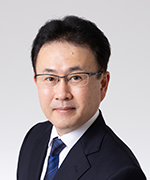ご挨拶
第38回日本脳神経外科国際学会フォーラム(JNEF)
第37回日本脳神経外科同時通訳夏季研修会(SIGNS)
会長 樋口 佳則(Yoshinori Higuchi)
千葉大学大学院医学研究院 脳神経外科学 教授

第38回日本脳神経外科国際学会フォーラム(Japan Neurosurgery English Forum, JNEF)および第37回日本脳神経外科同時通訳夏季研修会(Simultaneous Interpreters Group in Neurosurgery, SIGNS)を2024年7月19、 20日に一橋講堂にて開催いたします。本学が開催させていただくのは、2007年、第22回が佐伯直勝会長(現千葉大学名誉教授)により、かずさアカデミアホールにて行われて以来17年ぶりとなります。
ここ数年、多人数が集まる現地開催学会制限され、Zoomなどリモートでの学会参加にシフトし、卒後間もない専攻医は現地での学会に参加したことがないほどの状況となっていました。2023年5月に、COVID-19の感染症法上の位置付けが2類から5類になり、世の中はゆっくりと、そして確実に元の状態に戻りつつあります。リモート学会は便利であった反面、リモートでは不十分な点を我々は身をもって体験することになりました。令和6年度は、完全なポストコロナの時代に入ります。Web配信なしの学会も多くなり、まさに演者のpassionが直接伝わる環境に戻ります。
英語環境に関しては、機械翻訳、音声翻訳ツールもここ数年でめざましい発展と普及が進み、新市場型破壊的イノベーションにより、英語のみならず外国語に対する壁は低くなっています。また、情報のインプットの量の増加は、加速していくことは疑う余地はありません。JNEFおよびSIGNSは、若い脳神経外科医が海外に羽ばたく準備期間のトレーニング、ならびに日本に学びに来る海外の脳神経外科医に、日本の高い技術と研究を伝える責務をもっていると考えています。そのため、これからも新しい技術を取り入れる意味を込めて、今回の学会ポスターを作成いたしました。
一方、アウトプットに関してはどうでしょうか?聞く気のある相手に話すことは、比較的どのレベルの英語でも、相手は努力して理解しようとしてくれます。これが、相手に売り込む立場になれば、話しは全く異なり、米国留学時に痛感したことのひとつです。英語での学会発表のスタートは、まさにこの立場であり、プレゼンテーションマナーを守り、かつ適切な英語で、わかりやすいスライドを用いてプレゼンテーションすることが重要であることに変わりありません。
同時通訳で難儀と感じることは、日本語は単語の語順が一定ではなく、最後まで聞かないと、その文章がTrueかNot trueかが判断できない。主語がない文章が乱発されるなどいろいろあります。我々が、学会での講演を完璧な日本語(原稿棒読み)で行えば、人間が行う同時通訳はもしかすると不要かもしれません。しかし、我々の母国語である日本語はこの曖昧があるからこそ、相手に想像させ、しかも短い文章で伝えることを可能にした言語だと考えます。演者の意図をくみ取り、それを伝えることも、脳神経外科医が行う同時通訳の大切な部分と考えます。同時通訳を上手にする方法をChatGPT4.0に聞いてみると、プロ(Trainer)の同時通訳者との学び、実践経験の重要性、フィードバックの受け入れ、さらに焦らず、着実に取り組むことが大切である、といっていました。本学会、研修会は、まさにこれらを実践する場として重要なことを再確認しました。
ポストコロナでいよいよ海外で活躍する機会が増えてきます。特に若手の先生方には、英語を学んで国際学会への参加、英文論文作成、海外施設見学や留学などに積極的に挑戦していただきたいと思っております。本会がそのためのきっかけとなれば幸いです。
皆様のご参加をお待ちしております。東京でお会いできることを楽しみにしております。
2024年3月11日
Greeting from
the 38th Conference of Japan Neurosurgery English Forum (JNEF) and
the 37th Conference of Simultaneous Interpreters Group in Neurosurgery (SIGNS)
Dear Colleagues and Friends,
We would like to welcome you to Tokyo for the 38th Conference of Japan Neurosurgery English Forum (JNEF) and the 37th Conference of Simultaneous Interpreters Group in Neurosurgery (SIGNS). This will take place on July 19 and 20, 2024 at Hitotsubashi Hall. It has been 17 years since our department organized the 22nd SIGNS Conference, which was chaired by Professor Naokatsu Saeki (currently Professor Emeritus at Chiba University) and held at Kazusa Academia Hall in 2007.
In recent years, due to restrictions on large in-person gatherings, there has been a shift towards remote participation via videoconferencing platforms such as Zoom, to the extent that many recent graduates have never attended a local conference. However, in May 2023, the classification of COVID-19 under the Infectious Diseases Control Law was downgraded from Category II to Category V, signaling a gradual and steady return to normalcy. While remote conferences offered convenience, we also experienced their limitations firsthand. As we approach fiscal year 2024, we are moving into a fully post-COVID era. Many conferences will be held without webcasting, restoring an environment where the speakers' passion can be directly conveyed.
In the realm of English language landscape, machine translation and speech translation devices have seen significant advancements and adoption in recent years. These disruptive innovations have effectively lowered the barriers not only to English but also to other foreign languages. Moreover, the influx of information will undoubtedly continue to accelerate. We believe that JNEF and SIGNS have the responsibility to train young neurosurgeons gearing up for their overseas endeavors and to share Japan’s advanced techniques and research with foreign neurosurgeons to expand their expertise. With that in mind, we designed the poster for this conference to symbolize our ongoing efforts to embrace new technologies.
I keenly experienced the following during my stay in the United States. When you speak to someone willing to listen, they will strive to understand you, regardless of your English proficiency level. However, the dynamics change completely when you are in a position to persuade others. Starting a conference presentation in English puts you in this exact position, when it is crucial to adhere to presentation etiquette, use appropriate English, and present slides in an accessible manner.
One of the challenges in simultaneous interpretation from Japanese to English is that there is not fixed word order, which makes it difficult to determine the truth value of a statement until it is fully heard. There are various other challenges, such as the frequent use of sentences without a clear subject. If we could deliver speeches at academic conferences in flawless Japanese (reading verbatim from a script), there would probably be no need for human simultaneous interpretation. However, it is precisely the ambiguity of our native Japanese language that enables us to engage listeners' imagination and convey information concisely. Grasping the speaker's intent and conveying it is an essential part of simultaneous interpretation performed by neurosurgeons. When I asked ChatGPT4.0 how to get better at simultaneous interpretation, it emphasized the importance of learning from professionals, gaining practical experience, accepting feedback, and doing it steadily without rushing. This reaffirmed the significance of our conference and workshop as venues for putting these suggestions into practice.
As we move into the post-COVID era, there will be more opportunities to pursue international endeavors. We especially encourage young professors to take a proactive approach to learning English, participating in international conferences, authoring papers in English, visiting overseas facilities, and pursuing educational opportunities abroad.
We hope this conference will serve as a catalyst for such endeavors. We look forward to your participation and to meeting you in Tokyo.
Warm regards,
Yoshinori Higuchi, MD, PhD
Department of Neurological Surgery,
Chiba University Graduate School of Medicine

